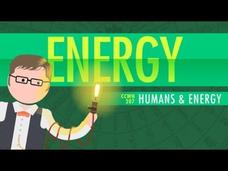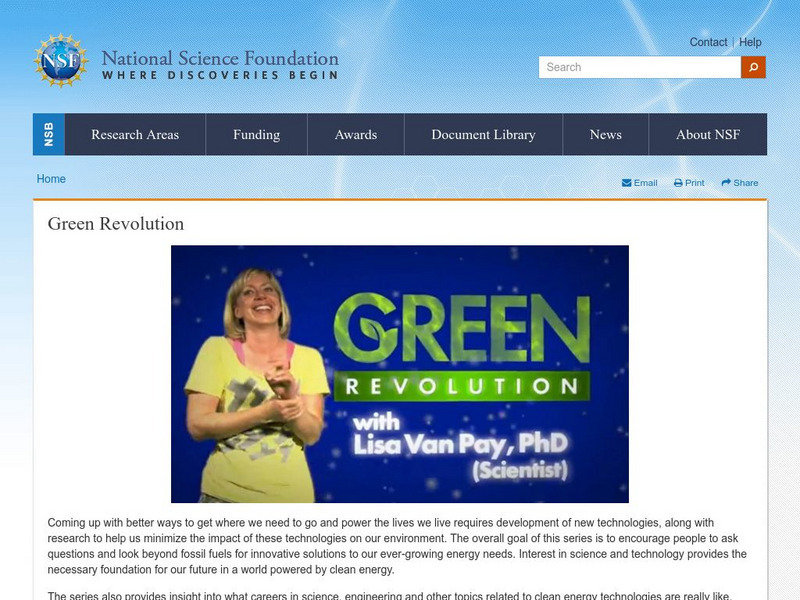Crash Course
The Anthropocene and the Near Future: Crash Course Big History #9
The Anthropocene covers the last century in an unofficial geological era. An informative video considers both the pros and cons of progress. It discusses the environmental impact, changes in lifestyle, political changes, wars, and...
PBS
Growing Appetites, Limited Resources
Did you know that, as the world's population increases, its demand for energy increases at an even faster rate? Learners watch a short video about the world's energy crisis before discussing the sustainable alternative energy sources....
Real Engineering
How Many Batteries Could Power the World? (ft. MinutePhysics)
Some old technology gets new life. Scholars learn how Tesla is planning to produce electric cars with batteries in a Real Engineering video. They see calculations that show how many lithium-ion battery factories would be necessary to...
Kurzgesagt – In a Nutshell
3 Reasons Why Nuclear Energy Is Awesome!—Part 3
Nuclear energy saves more lives than it harms. A powerful video explains the great things about nuclear energy and why we should increase nuclear power plants. It highlights the benefits for global warming and a new way to make nuclear...
Kurzgesagt – In a Nutshell
Fusion Power Explained—Future or Failure
A day without fusion is like a day without sunshine. The video explains what fusion is and how we might be able to create the energy on Earth rather than relying on the sun. It highlights the pros and cons of fusion power.
MinuteEarth
This Video Has Consumed 1497967.5 AA Batteries!
Do we really think about overall energy used when we watch that funny video for the fourth time? It adds up! Pupils watch as the energy used for Internet tasks is related to an equal number of AA batteries. The narrator compares watching...
Crash Course
Humans and Energy: Crash Course World History 207
Is flipping a switch and lighting up a room normal or miraculous? It depends where—and when—you live. Crash Course World History covers historical uses of energy, current uses of energy, and the possible future uses of energy with an...
Fuse School
Uses of Crude Oil Fractions
So many layers, so many uses! Chemistry pupils discover the many uses of the molecules separated from crude oil during the process of fractional distillation. The animated video covers such materials as plastic, kerosene, and diesel....
Fuse School
Fractional Distillation
How do you untangle the hydrocarbon chains found in crude oil? The resource explains the process of fractional distillation, the method used to separate all of the useful molecules found in the world's most important nonrenewable...
TED-Ed
Why Don't Perpetual Motion Machines Ever Work?
It turns out that some laws were definitely not meant to be broken! A short illustrative video explains why the first and second laws of thermodynamics prevent perpetual motion machines from actually moving perpetually — and why...
Curated OER
Natural Gas
Did you know that natural gas is the cleanest burning fossil fuel? The cost of processing natural gas is significantly less than processing even nuclear and wind energy. In this fast-moving, upbeat video, viewers learn about the benefits...
Curated OER
Sources of Energy
Explore the various sources of energy with your junior scientists. Rather than a video, this is a series of slides that the narrator simply reads aloud. Unless your learners have the energy to keep themselves alert, this may not be the...
Curated OER
Alternative Energy
Solar energy and biofuels are introduced as future alternative sources of energy. The National Renewable Energy Laboratory has made it their mission to make these alternatives more efficient and competitive with the use of fossil fuels....
Curated OER
Fossil-Fuelled Electricity - How it Works
Thermal power is electricity generated by the burning of fossil fuels. Through a series of video clips and computer animations, youngsters learn about how coal is used to produce useful electricity. The website provides quizzes that are...
PBS
Pbs News Hour Extra: Sun in a Bottle
This video and follow up questions shares the scientific discovery of man-made fusion. [6:36]
National Science Foundation
National Science Foundation: Green Revolution
Videos on different forms of alternative energy and various green initiatives, e.g., green roofs.
PBS
Pbs Learning Media: Energy Sources
This video segment illustrates a variety of energy sources used to generate electricity, some of which are in use and some of which are under exploration. [6:09]
PBS
Pbs Learning Media: Designing Future Cities: Alternative Energy
In this video segment adapted from ZOOM, visit a class as they design a city of the future that will use solar, wind, and water power to fuel its economy. [2:12]
PBS
Nova Labs: Energy Defined
There are textbook definitions of energy, and then there's the energy we experience in our daily lives. So what is energy, and why are we on a never-ending search for new sources? [2:41]
PBS
Nova Labs: Solar Power
The Sun is a reliable energy source that we can harness and convert into electricity in several ways. So why are renewable and clean solar energy systems not used more widely? [3:00]
The Atlantic Monthly Group
The Atlantic: How Much Energy Does the u.s. Use?
Do you know the massive amount of energy the U.S. consumes? This video will explore our dependence on oil versus our dependence on renewable resources. [1:59]
Learn Engineering
Learn Engineering: How Does a Thermal Power Plant Work?
A video explaining how thermal power plants produce electricity by high pressure and high-temperature steam rotating a steam turbine. Site also includes an article which discusses all concepts covered in the video. [7:50]
Crash Course
Crash Course:here Comes the Sun: Crash Course Kids #5.1
"Ever hear of "Sol"? Sure you have! It's our Sun! It sits at the center of our 8 planet solar system, providing us with heat and light. But how does that energy get to us? In this episode of Crash Course Kids, Sabrina chats about the...
Khan Academy
Khan Academy: Threshold 8: The Modern Revolution
The Modern Revolution began about 200 ago and created the world we live in today. This video explains the key ingredients needed for the Modern Revolution. [2:37]





















